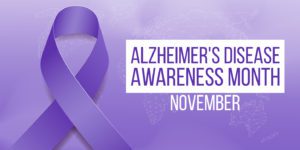Alzheimer’s Awareness Month

Nationally, November is known as Alzheimer’s Awareness Month. President Reagan made this designation in 1983 after recognizing the need for heightened disease awareness. While less than two million Americans were living with Alzheimer’s then, the number has since increased to nearly six million. The number of Americans with Alzheimer’s is projected to surpass 13.8 million by 2060. More than 11 million American caregivers provide over 15.3 billion hours of unpaid care for Alzheimer’s patients each year. These statistics show that raising awareness about this cruel disease is more important than ever to improve the quality of life for those living with it and those who love and care for those previously undiagnosed.
Alzheimer’s disease is the most common type of dementia, accounting for 60-80% of all cases, and ranks as the sixth leading cause of death in the United States. With memory loss symptoms and cognitive decline significant enough to interfere with daily life, it impacts thinking and behavior. It is a progressive neurodegenerative disease that worsens over time so the individual eventually loses the ability to accomplish daily tasks.
One of the first warning signs of Alzheimer’s is memory loss, such as frequently forgetting names, words, or new information. It’s important to distinguish that occasional mild memory lapses and forgetfulness do not signal the beginning of the disease. These can usually be attributed to the normal aging process. Once the memory struggles become significant enough to impair one’s ability to accomplish everyday tasks independently, however, it may be time to visit the doctor. (These include using the phone, shopping, preparing meals, housekeeping, transportation, taking medications, or managing finances.)
The progression of Alzheimer’s disease is fairly predictable. Memory, communication, and planning struggles are generally mild, even if they are frequent. As the disease progresses, the individual experiences a gradual change in behavior and more noticeable declines in memory, the ability to navigate, and communication. At the moderate stage, common symptoms are impaired judgment, frequent confusion, wandering, repeated questioning, and suspicion of others. Multi-step tasks can become challenging. At the severe stages, individuals can become unaware of the environment, be unable to converse and require daily assistance with personal needs.
After diagnosis, those with Alzheimer’s typically live between three to 10 years, but some survive for up to 20 years. Failing health is largely due to brain cell deterioration and death. Still, the official causes of death usually fall, pneumonia, or malnutrition (since the ability to eat and swallow is affected in advanced stages). Those diagnosed with Alzheimer’s are usually over age 65, though a small percentage of individuals are diagnosed with early-onset Alzheimer’s (usually hereditary) in their thirties, forties, and fifties.
During Alzheimer’s Awareness Month, the goal is to raise awareness of the symptoms of the disease so people can recognize the early signs in loved ones. Early diagnosis is key to optimal health management. Early signs to look for are memory loss, confusion with time or place, trouble planning or organizing, difficulty with problem-solving, communication struggles, misplacing items, and mood or personality changes. Being in optimal physical health, getting regular medical follow-ups, socializing, being active, and eating nutritiously can make a big difference in both the severity of symptoms and in disease progression.
There are currently no drugs or treatments that can cure Alzheimer’s disease. The available medications or treatments can only temporarily improve symptoms, slow down memory loss, or help with managing behavioral problems. If you are caring for someone with Alzheimer’s, the best thing you can do is to create a predictable daily routine and keep things simple. Structure and familiarity help the person know what to expect and reduce day/night confusion. Try talking at eye level from the front and using yes/no questions. Be reassuring and validating; smile, use touch, and continually let the person know she is safe and loved. Don’t feel you always need to share the whole truth; for example, if the individual asks for someone who has passed away, say the person is not here right now.
As part of the educational efforts surrounding Alzheimer’s Awareness Month, many organizations hold “memory walks” (typically in September or October) to raise awareness and funds for research. We invite any interested parties to either join the Cahoon team at next year’s memory walks, create their memory walk in honor of a loved one, or join any team where the walk is convenient for them to participate. The Cape Cod Alzheimer’s Family Support Center (https://www.alzfamilysupport.org) also holds a walk each October to raise funds to support the organization’s free services that help local families navigate the complexities and challenges of living with Alzheimer’s and related brain diseases.
Others looking to capitalize on the nationwide attention to Alzheimer’s during November choose to have themselves or a loved one participate in the free, confidential National Memory Screening Program (https://alzfdn.org/memory-screening/ ). This series of questions measure your language skills, thinking ability, and intellectual functions, and can detect early warning signs of oncoming Alzheimer’s disease. These efforts, among others, can help improve our awareness of and early action against this dreadful disease.
